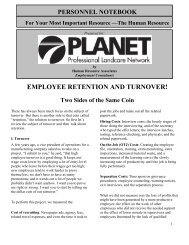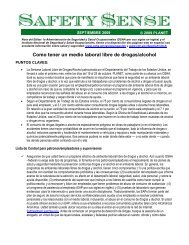Economic Impacts of the Green Industry in the - Urban Forest ...
Economic Impacts of the Green Industry in the - Urban Forest ...
Economic Impacts of the Green Industry in the - Urban Forest ...
Create successful ePaper yourself
Turn your PDF publications into a flip-book with our unique Google optimized e-Paper software.
imports, chrysan<strong>the</strong>mums at 11 percent, and carnations at 10 percent. Imports <strong>of</strong> flower<strong>in</strong>g plants from Asia, such<br />
as orchids, and nursery plants and trees from Canada limit wholesale prices that domestic growers <strong>of</strong> <strong>the</strong>se<br />
products can charge without los<strong>in</strong>g market share. These help expla<strong>in</strong> <strong>in</strong> part why wholesale prices <strong>of</strong> U.S.-grown<br />
potted flower<strong>in</strong>g plants and bedd<strong>in</strong>g and garden plants have been generally flat s<strong>in</strong>ce 2000. But for growers <strong>in</strong> <strong>the</strong><br />
Midwestern and Eastern States, prices have improved relative to some growers <strong>in</strong> <strong>the</strong> South and especially <strong>in</strong><br />
contrast to growers <strong>in</strong> <strong>the</strong> West.<br />
LAWN AND GARDEN EQUIPMENT<br />
U.S. demand for power lawn and garden equipment is projected to rise over 3 percent per year through 2009,<br />
reach<strong>in</strong>g $10.7 billion, accord<strong>in</strong>g to a new study by <strong>the</strong> Freedonia Group. An expansion <strong>of</strong> <strong>the</strong> key 55-64 year-old<br />
age group will contribute to ga<strong>in</strong>s, <strong>the</strong> report says, as this group typically trades up from older, less expensive<br />
equipment to higher-end products, or <strong>in</strong>creas<strong>in</strong>gly engages pr<strong>of</strong>essional lawn care services. Growth will also<br />
result from product <strong>in</strong>novations and upgrades, driven by consumer demand for equipment with <strong>in</strong>creased<br />
horsepower, additional features and lighter weight. The cont<strong>in</strong>ued popularity <strong>of</strong> golf will also present<br />
opportunities, as a grow<strong>in</strong>g number <strong>of</strong> golf courses compete to have <strong>the</strong> best play<strong>in</strong>g surfaces.<br />
The residential market dom<strong>in</strong>ates power lawn and garden equipment sales, represent<strong>in</strong>g approximately two-thirds<br />
<strong>of</strong> <strong>the</strong> total <strong>in</strong> 2004. However, advances <strong>in</strong> <strong>the</strong> commercial market have outpaced <strong>the</strong> residential market <strong>in</strong> recent<br />
years, bolstered by <strong>the</strong> tremendous growth <strong>in</strong> <strong>the</strong> sales <strong>of</strong> zero-turn radius turf mowers. In addition, <strong>the</strong> cont<strong>in</strong>u<strong>in</strong>g<br />
rise <strong>in</strong> <strong>the</strong> number <strong>of</strong> pr<strong>of</strong>essional landscapers (<strong>in</strong> part a byproduct <strong>of</strong> an ag<strong>in</strong>g population) has boosted<br />
commercial demand. Although gas-powered equipment will rema<strong>in</strong> dom<strong>in</strong>ant, electric-powered products are<br />
expected to post significantly stronger ga<strong>in</strong>s through 2009. Battery-powered equipment will fare particularly well,<br />
as improved battery technology is <strong>in</strong>troduced. Cordless products are easy to use and have a better environmental<br />
image than competitive products. In addition, <strong>the</strong>y appeal to women, who account for a grow<strong>in</strong>g portion <strong>of</strong><br />
equipment sales and use.<br />
Lawnmowers will cont<strong>in</strong>ue to be <strong>the</strong> largest product segment, benefit<strong>in</strong>g from <strong>the</strong>ir wide use <strong>in</strong> both residential<br />
and commercial applications. Turf and grounds equipment is expected to post <strong>the</strong> best ga<strong>in</strong>s, because <strong>of</strong><br />
cont<strong>in</strong>u<strong>in</strong>g growth <strong>in</strong> <strong>the</strong> pr<strong>of</strong>essional landscap<strong>in</strong>g services <strong>in</strong>dustry and <strong>the</strong> ris<strong>in</strong>g number <strong>of</strong> golf courses.<br />
Despite <strong>the</strong> improv<strong>in</strong>g durability <strong>of</strong> orig<strong>in</strong>al equipment, parts and accessories will outpace <strong>the</strong> <strong>in</strong>dustry average<br />
due to <strong>the</strong> ris<strong>in</strong>g amount <strong>of</strong> stock <strong>in</strong> use.<br />
HORTICULTURAL SERVICE FIRMS<br />
Landscape-related firms surveyed <strong>in</strong> August 2004 by Lawn & Landscape magaz<strong>in</strong>e said that 2004 bus<strong>in</strong>ess<br />
revenue is up an average <strong>of</strong> 17.4 percent, <strong>in</strong>dividual service sales have <strong>in</strong>creased <strong>in</strong> all categories, and net pr<strong>of</strong>its<br />
are projected to rise. Contribut<strong>in</strong>g to <strong>the</strong> <strong>in</strong>dustry’s sound stand<strong>in</strong>g is an <strong>in</strong>crease <strong>in</strong> consumer spend<strong>in</strong>g and a<br />
healthy hous<strong>in</strong>g market. Overall, 2004 represented encourag<strong>in</strong>g economic times for <strong>the</strong> <strong>Green</strong> <strong>Industry</strong>. In<br />
contrast to previous annual surveys, contractors say <strong>the</strong>ir 2004/2005 concerns have shifted from matters such as<br />
f<strong>in</strong>d<strong>in</strong>g adequate labor to cost-based concerns such as escalat<strong>in</strong>g health <strong>in</strong>surance and workers’ compensation<br />
rates, as well as <strong>in</strong>creased fuel expenses. Many contractors are focus<strong>in</strong>g on rais<strong>in</strong>g bus<strong>in</strong>ess efficiency to combat<br />
<strong>the</strong>se costs. Landscape companies are younger today, with <strong>the</strong> average age be<strong>in</strong>g 13.6 years old <strong>in</strong> 2004 versus<br />
17.7 years old <strong>in</strong> 1999. In fact, a greater percentage <strong>of</strong> contractors – 28 percent – have been <strong>in</strong> bus<strong>in</strong>ess less than<br />
five years, compared to 12 percent <strong>in</strong> 2000, 15 percent <strong>in</strong> 2001 and 17 percent <strong>in</strong> 2003. Landscape companies that<br />
have operated more than five years <strong>in</strong>clude 23 percent who have been <strong>in</strong> bus<strong>in</strong>ess five to n<strong>in</strong>e years, 25 percent<br />
who have been <strong>in</strong> bus<strong>in</strong>ess 10 to 15 years, and 24 percent who have been <strong>in</strong> bus<strong>in</strong>ess more than 20 years. Despite<br />
<strong>the</strong> fact that <strong>the</strong>se companies are younger, <strong>the</strong>y are generat<strong>in</strong>g more revenue, on average, today at $732,353,<br />
compared to $694,300 <strong>in</strong> 2002.<br />
In terms <strong>of</strong> growth, <strong>the</strong> percentage <strong>of</strong> contractors who said <strong>the</strong>ir total gross sales revenue would <strong>in</strong>crease <strong>in</strong> 2004<br />
surpassed <strong>the</strong> percentage who felt this way <strong>in</strong> previous years. For <strong>in</strong>stance, 84 percent <strong>of</strong> contractors said <strong>the</strong>ir<br />
2004 revenue would <strong>in</strong>crease compared to 57 percent <strong>in</strong> 2003 or 59 percent <strong>in</strong> 2002. In fact, go<strong>in</strong>g back to 1997,<br />
<strong>the</strong> percentage <strong>of</strong> contractors predict<strong>in</strong>g growth for a s<strong>in</strong>gle year has never been higher than <strong>in</strong> 2004. The next<br />
closest percentage <strong>of</strong> contractors foresee<strong>in</strong>g growth was 72 percent <strong>in</strong> 1998. Contractors predicted an <strong>in</strong>crease <strong>of</strong><br />
net 17.4 percent this year. This is up from last year’s 13 percent, but down when compared to <strong>the</strong> rates<br />
13
















